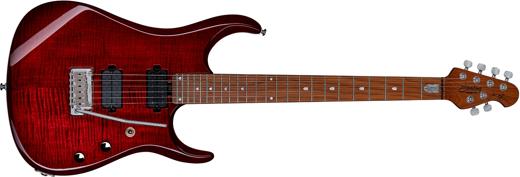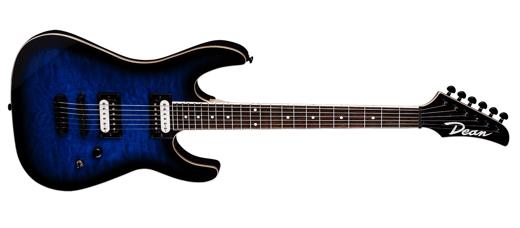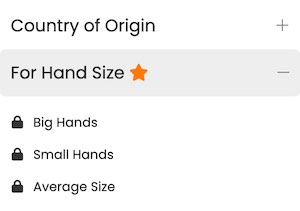Ibanez JS2GD Review & Prices
- From Ibanez's 2022 JS series
- Joe Satriani Signature
- Made in Japan
- 6 strings
- 25.5"'' scale
- 9.843" Fretboard Radius
- Alder body
- 1pc Maple neck
- Rosewood fretboard
- Bridge pickup: DiMarzio FRED (Humbucker/Passive)
- Middle pickup: DiMarzio Satch Track (Humbucker/Passive)
- Neck pickup: DiMarzio Satch Track (Humbucker/Passive)
- 1 volume and 1 tone Dome knobs
- 3-way Switch
- Edge tremolo bridge
- JS Bolt-On neck
- 22 Medium Gold frets
- Gotoh machine heads tuners
- Compare Specs >
Our Scores and Tone Evaluation
- Heavy Metal
- Hard Rock
- Jazz
- Blues
- Funk
- Country
Ibanez JS2GD
- Gold Frets
- Made in Japan
- Expensive Wood
- Locking Nut
- Top Brand Pickups
- Coil Split Pickups
- Tremolo
- Retainer Bar
- No Locking Tuners
- No Neck-Through Build
- No Weight Relief
- No Luminescent Inlay
- No Compound Radius Fretboard
- No 21:1 Tuner Ratio
- No Strap Lock
Price Overview
Its average competitor's price is $3000, which means that the Ibanez JS2GD costs around 93% more than the competition. It might be due to it having additional features, but know that you can find cheaper similar alternatives. This takes into account all instruments of the same category in our database with 6 strings and Double Locking bridge that are made in Japan.
These are affiliate links. We may earn a fee if you purchase after clicking. These prices are prone to error. Make sure you're buying the right product after clicking on a link from our site. We are not liable if you buy the wrong product after following these links. As an Amazon Associate site we earn from qualifying purchases.
Videos





Your feedback
Not all instruments are created equally. That's why it's important to have different opinions. Here's what our users who have played this instrument say. If you've played it before, help others by voting below!
Weight
VoteTuning stability
VoteNeck speed (thickness)
VoteNeck access to high frets
VoteNeck profile shape
VoteFret edges
VotePickups noise
VotePickups power
VoteIs it Easy to Play?
The Ibanez JS2GD meets 5 out of our 8 criteria items for beginner friendliness, which means that it's a good guitar to start with as a complete beginner. This takes into account the type of frets, scale length, nut width, bridge type, fretboard radius, and neck profile to determine the easiest combination for new players to get used to.
New Player Friendliness
Ibanez JS2GD- Comfortable shape
- Comfortable fretboard
- Tall frets
- Narrow nut
- Comfortable neck
- Short scale
- Locking tuners
- Easy-to-use bridge
Hand Size Comfortability
After taking into account the neck profile, scale size, fretboard radius, and nut width, we can conclude that the Ibanez JS2GD's construction favors people with relatively small hands.
Nevertheless, this comes down in the end to personal preference. Make sure you test this guitar—or another one with similar characteristics—before buying.
Scale Length
Scale length is the distance the strings will span between the bridge and the nut. It can tell you a lot about the overall playability and tone of the instrument. A longer scale length means longer distance between frets, brighter tone and more string tension—which means lower action, but more difficult bending of the strings.
Here's the Ibanez JS2GD's 25.5" scale length compared to other common sizes:
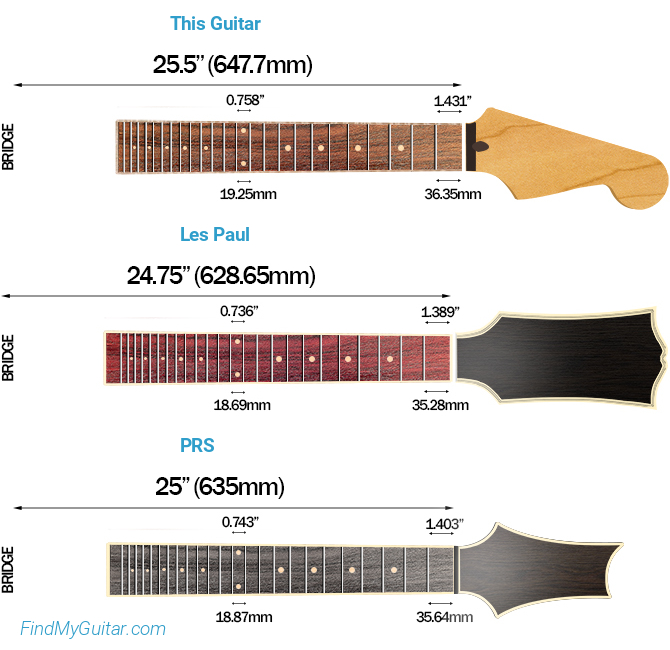
This is the same scale length used in Stratocaster guitars, and it's one of the main reasons they have such a bright sound. It's considered a long scale when compared to most non-baritone guitars.
Since the distance between bridge and nut is relatively long, you'll need to give the strings more tension to get them in tune. This higher tension will allow for a couple of things. First, you can get a lower action (get the strings closer to the fretboard) because the strings won't 'wiggle' too much when pluck and won't cause fret buzz. This can allow you to use lower tunings without increasing your string gauge, and it will make it easier to press down the strings fast.
However, the frets will also have a wider separation between each other, which can make it harder to play, especially if you got small hands. The higher tension will also make the strings feel stiffer, so bending will require more strength.
Neck Profile

The neck profile tells you the thickness (neck depth) and shape in cross section. Every difference will completely change the feeling and comfortability of the neck. This is a highly subjective thing, but most players indeed prefer certain types of necks (like Cs and Ds) because they feel nice in most hands.
The Ibanez JS2GD's neck thickness is approximately 0.79'' (20.1mm) at the first fret, and 0.88'' (22.4mm) at the twelfth.
These measurements were taken either from the official Ibanez website, or, in case this information wasn't provided, by researching multiple online marketplaces and forums where owners of this model have posted their measurements.
It has a C type neck. C-shaped necks like this have been the most popular for the last years. The reason is that they feel good in most hands. It's generally a thin neck that doesn't get in your way when playing fast, but that also has enough mass to give your hands a comfortable grip for chords if they aren't too big.
Thin necks like this make it easier to move your hand across the neck and it helps when playing fast solos, especially if you like to leave your thumb free while playing high on the fretboard. However, thinner necks are also weaker and will need adjustment more often than a thicker neck.
Fretboard Radius
When it comes to fingerboard radius, personal preference will dictate which one is better for you. However, most people seem to agree that a more curved (lower) radius will make it easier to play chords while a less curved (higher) radius is better for soloing and bending.
The Ibanez JS2GD has a 9.843" fingerboard radius.
Here's an image comparing this fretboard radius to other popular choices:

This is a radius that makes it comfortable to play chords, but that's just slightly flatter than the typical Strat fingerboard. It's still not as flat as a Les Paul, so it might not be as comfortable for soloing. The feel sits right in between a Strat and a Les Paul, although it feels more like the former.
Compound radius fingerboards give the best of both worlds. Unfortunately, the Ibanez JS2GD has the same radius across the board.
Playability compared to main competitors
Nut Width
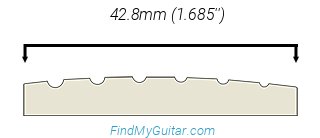
The Ibanez JS2GD has a nut width of 42.8mm (1.685''). This is considered a narrow width for a 6-string guitar. This means that this guitar will have a narrower string separation at the nut, which will affect your fretting hand.
If you are a player with big hands, you might find it difficult to play chords without muting strings. However, this is good for players who have smaller hands, as it will allow them to reach each string more easily at the nut.
Frets
The Ibanez JS2GD has 22 frets. Even though 24 frets has become really popular, there's still a good reason to get fewer frets; the pickup at the neck position will be further away from the bridge. This makes the neck pickup achieve a warmer tone. You might want this if you're playing Jazz or similar genres.
However, if you don't care about the warmer neck pickup, more frets will always be better. It's always nice to have the option to play higher notes if you want to.
Finally, this guitar has EVO gold frets. These sit right between nickel silver and stainless steel in terms of durability. They have the plus of looking absolutely stunning thanks to the golden finish.
Fret Size

Finally, let's talk about fret size. Some people prefer tall frets because it's easier to press the strings and perform bends since there's less friction against the fretboard. On the other hand, some people like shorter frets because they like to touch the fretboard when playing, or because they got heavy hands and tend to press too much on the string and alter the of the note pitch accidently.
The Ibanez JS2GD's frets are Medium size. With medium frets, you can feel the fretboard more than with jumbo frets, but it's still easier to press the strings cleanly than with small frets; notes might change their pitch just slightly if you press hard on the fret. Also, if you need to do some fret leveling after years of playing, you'll have some room to sand them down without having to replace them.
Playability Score
Tone Analysis
Wood will have little influence in the final tone of an electric guitar or bass. Instead, the hardware, especially the pickups, will be the most important thing to look at. Bur first, let's see the quality of the wood.
Wood



Alder Body: This is a lightweight type of wood that was popularized by Fender. According to them, it's a wood that offers a balanced tone but that favors the upper midrange slightly.
Maple Neck: This is one of the most popular types of wood used in all kinds of guitars. It's heavy, strong and compact, which makes it great for necks. However, it's also used for fretboards, bodies and tops due to its light color, resistance and beautiful patterns. When it comes to tone, it highlights the mid and high frequencies.
Rosewood Fretboard: Since the ban of Brazillian Rosewood, this has become a rare and expensive wood. It's not usually used for guitar bodies because of this, and also because it's heavy. Instead, it's used mainly for fretboards. Sometimes it's also used for necks because it's an extremely hard wood (even harder than maple). Its tonality tends to favor warm tones.
Pickups
This guitar comes with pickups from one of the top brands: DiMarzio. So you can expect well built pickups with great sound that shouldn't need an upgrade anytime soon.
These are passive pickups, so you can expect a rounder sound and a moderade level of output.
The Ibanez JS2GD's configuration is HHH. If you like warm tones, three Humbuckers will give you all the warmness you want, but also tons of output power. The advantage of having three humbucking pickups instead of a combination of single-coils and humbuckers is that you won't hear volume differences when switching to other pickups. And since they're all humbucker pickups, you don't need to adjust the middle pickup so high that it will get in the way of your pick.
More with the same pickups
Versatility
It comes with the popular 3-way switch that is present in most guitars. For more versatility, players tend to prefer a 5-way switch, although it all depends on what you want to use your guitar for.
It has a Coil Split option. It allows you to 'split' or turn off pickup coils to get even more tones in combination with the pickup selector. When used with humbucker pickups, it'll reduce the output and increase their clarity, turning them essentially into single-coil pickups.
Diagram
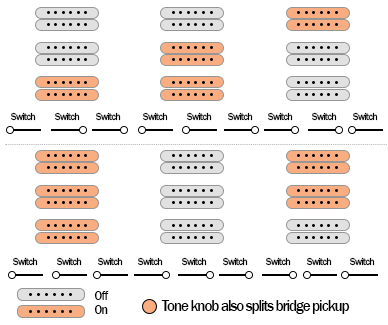
What music genre is it good for?
As a 6 strings, Solid Body guitar with HHH configuration and Passive pickups, we'd recommend it for genres like Hard Rock or similar. However, you can use almost any guitar for any genre. This is just the typical type of music for this particular one.
Sound Score
Build Quality Analysis
Country of Origin
Knowing where the instrument is produced is a good way to know how well it's built. Some manufacturing countries are known for having higher quality standards. For example, most expensive instruments are made in the US or Japan, but there are some exceptionally great countries—like South Korea—that are building a good reputation.
The Ibanez JS2GD is made in Japan. You should expect a high-quality guitar with excellent quality control. It can be compared to guitars made in the US, which is why they're also expensive.
Bridge
Edge tremolo: It's an improved version of the Floyd Rose bridge. It comes with a push-in arm, less bulky saddles, replaceable knife edges and with fine-tuners well positioned to avoid interfering with palm muting, and more mass for increased sustain. Like Floyd Roses, it takes more work to set up properly than simpler bridges.
Nut Material
Another important thing to analyze is the nut material, as it's one of the most important aspects that can affect the sound and playability of your guitar. A well-cut nut will make sure it stays in tune and will make it more comfortable to play.
In this case, the Ibanez JS2GD has a Locking nut. Instead of the typical nut, this nut locks the strings in place and will make them stay in tune even after heavy tremolo use. This type of nut provides the best tune stability, but they also make the guitar more expensive.
It also comes with a retainer bar for the locking nut, which is a helpful addition. Without it, the strings would change pitch once you lock down the nut, so you'd have to make more micro-adjustments at the bridge to tune it correctly.
Neck Joint
The neck joint is the part where the neck of the guitar meets the body. There are three main techniques to attach both parts together: Set-In, Bolt-On and Neck-Through. The latter two provide different advantages, although neck-throughs are the most expensive.
This guitar has a Bolt-On neck joint. Even though this type of neck was looked down upon for a long time, nowadays bolt-on necks are well built and provide just as much sustain as any other join method. First of all, it's cheap to make because it consists of simply 4 bolts that attach the neck to the body. And you can travel with the guitar more easily, swap out the neck if you damage it, or upgrade to a more comfortable neck later on.
Build Quality Score
All Specs
Ibanez JS2GDUser Reviews
Help others by sharing your opinion about this guitar. Note: to avoid spam, your review will be submitted for approval before appearing here.


